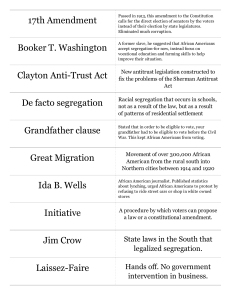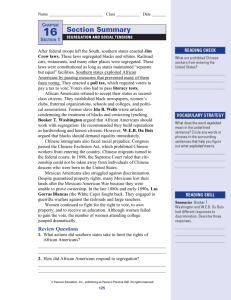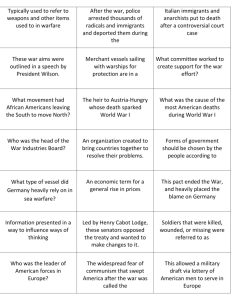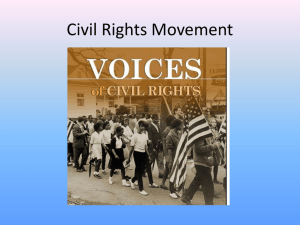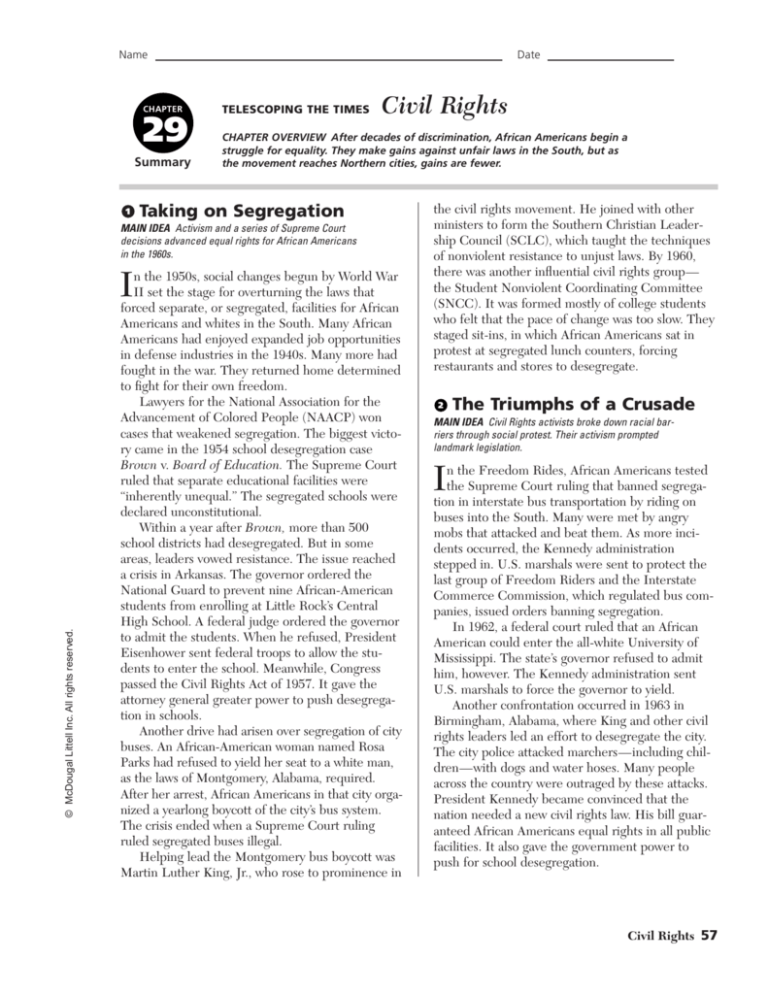
Name
CHAPTER
29
Summary
1
Date
TELESCOPING THE TIMES
Civil Rights
CHAPTER OVERVIEW After decades of discrimination, African Americans begin a
struggle for equality. They make gains against unfair laws in the South, but as
the movement reaches Northern cities, gains are fewer.
Taking on Segregation
MAIN IDEA Activism and a series of Supreme Court
decisions advanced equal rights for African Americans
in the 1960s.
© McDougal Littell Inc. All rights reserved.
I
n the 1950s, social changes begun by World War
II set the stage for overturning the laws that
forced separate, or segregated, facilities for African
Americans and whites in the South. Many African
Americans had enjoyed expanded job opportunities
in defense industries in the 1940s. Many more had
fought in the war. They returned home determined
to fight for their own freedom.
Lawyers for the National Association for the
Advancement of Colored People (NAACP) won
cases that weakened segregation. The biggest victory came in the 1954 school desegregation case
Brown v. Board of Education. The Supreme Court
ruled that separate educational facilities were
“inherently unequal.” The segregated schools were
declared unconstitutional.
Within a year after Brown, more than 500
school districts had desegregated. But in some
areas, leaders vowed resistance. The issue reached
a crisis in Arkansas. The governor ordered the
National Guard to prevent nine African-American
students from enrolling at Little Rock’s Central
High School. A federal judge ordered the governor
to admit the students. When he refused, President
Eisenhower sent federal troops to allow the students to enter the school. Meanwhile, Congress
passed the Civil Rights Act of 1957. It gave the
attorney general greater power to push desegregation in schools.
Another drive had arisen over segregation of city
buses. An African-American woman named Rosa
Parks had refused to yield her seat to a white man,
as the laws of Montgomery, Alabama, required.
After her arrest, African Americans in that city organized a yearlong boycott of the city’s bus system.
The crisis ended when a Supreme Court ruling
ruled segregated buses illegal.
Helping lead the Montgomery bus boycott was
Martin Luther King, Jr., who rose to prominence in
the civil rights movement. He joined with other
ministers to form the Southern Christian Leadership Council (SCLC), which taught the techniques
of nonviolent resistance to unjust laws. By 1960,
there was another influential civil rights group—
the Student Nonviolent Coordinating Committee
(SNCC). It was formed mostly of college students
who felt that the pace of change was too slow. They
staged sit-ins, in which African Americans sat in
protest at segregated lunch counters, forcing
restaurants and stores to desegregate.
2
The Triumphs of a Crusade
MAIN IDEA Civil Rights activists broke down racial barriers through social protest. Their activism prompted
landmark legislation.
I
n the Freedom Rides, African Americans tested
the Supreme Court ruling that banned segregation in interstate bus transportation by riding on
buses into the South. Many were met by angry
mobs that attacked and beat them. As more incidents occurred, the Kennedy administration
stepped in. U.S. marshals were sent to protect the
last group of Freedom Riders and the Interstate
Commerce Commission, which regulated bus companies, issued orders banning segregation.
In 1962, a federal court ruled that an African
American could enter the all-white University of
Mississippi. The state’s governor refused to admit
him, however. The Kennedy administration sent
U.S. marshals to force the governor to yield.
Another confrontation occurred in 1963 in
Birmingham, Alabama, where King and other civil
rights leaders led an effort to desegregate the city.
The city police attacked marchers—including children—with dogs and water hoses. Many people
across the country were outraged by these attacks.
President Kennedy became convinced that the
nation needed a new civil rights law. His bill guaranteed African Americans equal rights in all public
facilities. It also gave the government power to
push for school desegregation.
Civil Rights 57
Name
3
Challenges and Changes
in the Movement
MAIN IDEA Disagreements among civil rights groups
and the rise of black nationalism created a violent
period in the fight for civil rights.
T
he civil rights movement met difficulties as it
moved North. In the South the problem had
been unfair laws, called de jure segregation. In the
North, the problem was de facto segregation, which
arises from racist attitudes. It is harder to change
attitudes than to overturn unjust laws.
The Great Migration had brought tens of thousands of African Americans to Northern cities, but
“white flight” had left the cities poor and with few
jobs. African Americans were angered by these
conditions and by harsh treatment from largely
white police forces. This anger boiled over in several riots that brought many deaths and much damage to many cities from 1964 to 1968. President
Johnson had declared “war on poverty” to combat
some of the social ills that African Americans were
protesting. But the growing involvement in the
Vietnam War robbed the war on poverty of needed
resources.
58 Unit 8, Chapter 29
New African-American leaders arose, many of
them boosting black nationalism. Malcolm X began
by telling his audiences to use armed self-defense
when unlawfully attacked. He later urged pursuit of
peaceful means—especially voting—to win equality. He split with other leaders of his church. Then,
in 1965, he was assassinated.
Another split occurred between King and the
SCLC and other, younger, members of the movement. SNCC leaders began to use the slogan
“Black Power” to symbolize their call for AfricanAmerican pride and stronger resistance to racism.
The Black Panthers adopted military-style dress
and harsh words, raising fears among moderate
African Americans and many whites.
King objected to the fiery language of the Black
Power movement. He believed that it would have
evil consequences. It was he who suffered, however. In April 1968, King was shot and killed. Many
cities erupted in riots caused by African-Americans’
anger and frustration.
A commission reported to President Johnson
that the urban riots were caused by white racism
and the lack of opportunities for African
Americans. But the administration did not act, fearing the lack of white support for the sweeping
changes required. The civil rights movement had
achieved many triumphs, including the banning of
segregation in education, transportation, employment, and housing and the winning of voting rights.
Many problems remained, however, and de facto
segregation has continued throughout America
even up to today.
Review
1. How did the civil rights movement begin?
2. What events led Congress to pass the Civil
Rights and Voting Rights acts?
3. How did the civil rights movement change?
4. Why could the results of the movement be called
mixed?
© McDougal Littell Inc. All rights reserved.
Civil rights leaders staged a massive march in
Washington in August of 1963. More than 250,000
people showed up, urging passage of the civil rights
bill. After Kennedy was assassinated, President
Johnson pushed Congress to act. The Civil Rights
Act was passed in 1964.
Civil rights workers next began a campaign to
register African-American voters in the South.
They called it Freedom Summer. They met opposition and some violence. At the Democratic convention that summer, only two African American delegates were seated, leading some of the delegates to
feel betrayed.
In 1965, a harsh police response to a civil
rights march in Alabama led thousands from all
over the country to join the march. President
Johnson spurred Congress to pass the Voting
Rights Act. The law stripped away state laws that
had prevented African Americans from voting.
Civil Rights continued


